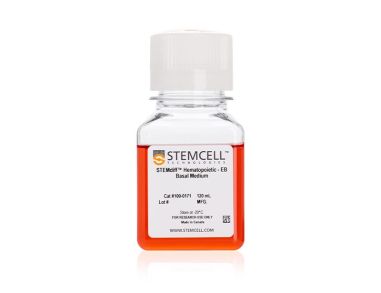搜索结果: 'methocult media formulations for human hematopoietic cells serum containing'
-
 健康与疾病状态的人造血集落 健康与疾病状态的人造血集落图谱
健康与疾病状态的人造血集落 健康与疾病状态的人造血集落图谱 -
 RosetteSep™人造血祖细胞富集抗体混合物 免疫密度负选试剂混合物
RosetteSep™人造血祖细胞富集抗体混合物 免疫密度负选试剂混合物 -
 STEMdiff™ 造血试剂盒 用于将人ES细胞或iPS细胞分化为造血祖细胞
STEMdiff™ 造血试剂盒 用于将人ES细胞或iPS细胞分化为造血祖细胞 -
 STEMdiff™造血分化 - EB基础培养基 用于生成拟胚体的无血清培养基,以支持下游淋系分化
STEMdiff™造血分化 - EB基础培养基 用于生成拟胚体的无血清培养基,以支持下游淋系分化 -
 含抗CD56的RosetteSep™ CTC富集抗体混合物 免疫密度负选试剂混合物
含抗CD56的RosetteSep™ CTC富集抗体混合物 免疫密度负选试剂混合物 -
 冻存的人脐带血CD34+细胞 冻存的人原代细胞
冻存的人脐带血CD34+细胞 冻存的人原代细胞 -
 冻存的人脐带血Pan T细胞 冻存的人原代细胞
冻存的人脐带血Pan T细胞 冻存的人原代细胞 -
 人iPSC衍生的视网膜色素上皮细胞 人诱导多能干细胞系分化的冻存的视网膜色素上皮细胞
人iPSC衍生的视网膜色素上皮细胞 人诱导多能干细胞系分化的冻存的视网膜色素上皮细胞 -
 含抗CD36的 RosetteSep™ CTC富集抗体混合物 免疫密度负选试剂混合物
含抗CD36的 RosetteSep™ CTC富集抗体混合物 免疫密度负选试剂混合物 -
 人iPSC衍生的间充质祖细胞 人诱导多能干细胞系SCTi003-A分化的冻存的间充质祖细胞
人iPSC衍生的间充质祖细胞 人诱导多能干细胞系SCTi003-A分化的冻存的间充质祖细胞 -
 MegaCult™-C cfu染色试剂盒 人CFU-Mk染色试剂盒
MegaCult™-C cfu染色试剂盒 人CFU-Mk染色试剂盒 -
 TeSR™-E7™重编程培养基(2组分) 无饲养层且不含动物成分的重编程培养基,用于人诱导性多能干细胞(iPS细胞)的诱导。
TeSR™-E7™重编程培养基(2组分) 无饲养层且不含动物成分的重编程培养基,用于人诱导性多能干细胞(iPS细胞)的诱导。


 EasySep™小鼠TIL(CD45)正选试剂盒
EasySep™小鼠TIL(CD45)正选试剂盒





 沪公网安备31010102008431号
沪公网安备31010102008431号